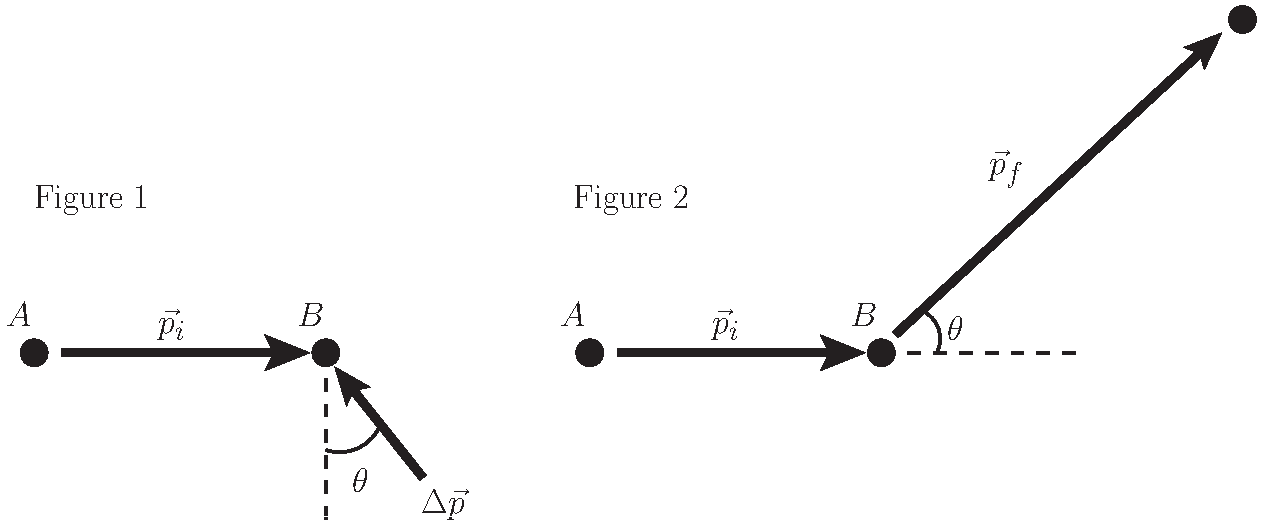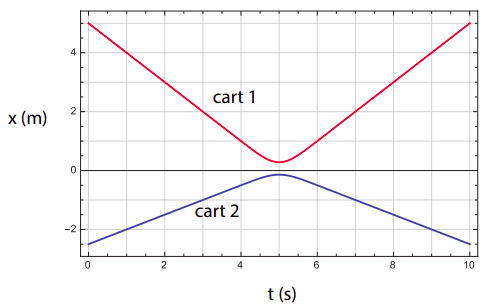2.4: Examples
- Page ID
- 63143

Consider an extra-heavy hockey puck, of mass 5.0 kg, traveling between points A and B in a straight line at a speed of 10.0 m/s. At point B, it gets hit by a hockey stick which delivers an impulse of \(\Delta\vec{p}\) to the puck. Using meter sticks and protractors, make scale drawings of this process on the whiteboards, and answer the following two questions:
- In figure 1, the amount of impulse delivered is \(\Delta p\)=30 kg m/s at an angle of 30\(\circ\), as shown.
- What is the final momentum of the hockey puck, \(p_f\)?
- In figure 2, we measure the final momentum \(p_f\) to be 100 kg m/s, moving at an angle of 40\(^\circ\), as shown.
- What was the impulse transferred to the hockey puck, \(\Delta p\)?
- At what angle did the impulse act on the puck?
Suppose a cart with mass \(m\) is moving to the right at a speed of \(v_0\). It collides with a cart of mass \(2m\), which is initially at rest. After the collision, the first cart rebounds to the left with a speed of \(\frac{1}{3}v_0\).
- How much impulse did the first cart deliver to the second? Use \(v_f\) as the final speed of the second cart.
- How much impulse did the second cart deliver to the first?
- Assuming that these two impulse transfers are the same, determine the final speed \(v_f\) in terms of the initial speed \(v_0\).
I drop a golf ball of mass \(m = 46\) g onto the floor, and right before it hits it has a velocity of \(v_{yi} = -2.2\) m/s.
- What is the momentum of the ball right before it hits the ground?
- If the speed of the ball after it bounces, \(v_{yf}\) , is 75\% of the speed right before it hits, what was the impulse the floor delivered to the ball?
- If the ball interacts with the floor for a time period \(\Delta t\), find an expression for the ratio between the average force the floor acted on the ball with to the weight of the ball \(mg\), in terms of \(v_{yi}\) , \(v_{yf}\) , \(g\), and \(\Delta t\).
- Calculate this ratio using \(\Delta t\) = 150 ms and the other parameters of the problem.
The graph shows a collision between two carts (possibly equipped with magnets so that they repel each other before they actually touch) on an air track. The inertia (mass) of cart 1 is 1 kg. Note: this is a position vs. time graph!
- What are the initial velocities of the carts?
- What are the final velocities of the carts?
- What is the mass of the second cart?
- Does the air track appear to be level? Why? (Hint: does the graph show any evidence of acceleration, for either cart, outside of the collision region?)
- At the collision time, is the change in velocity (\(\Delta v\) )of the first cart positive or negative? How about the second cart? (Justify your answers.)
- For the system consisting of the two carts, what is its initial (total) momentum? What is its final momentum?
- Imagine now that one of the magnets is reversed, so when the carts collide they stick to each other. What would then be the final momentum of the system? What would be its final velocity?
Figure \(\PageIndex{1}\): A collision between two carts
Solution
(a) All the velocities are to be calculated by picking an easy straight part of each curve and calculating
\[ v=\frac{\Delta x}{\Delta t} \nonumber \]
for suitable intervals. In this way one gets
\begin{aligned}
&v_{1 i}=-1 \: \frac{\mathrm{m}}{\mathrm{s}}\\
&v_{2 i}=0.5 \: \frac{\mathrm{m}}{\mathrm{s}}
\end{aligned}
(b) Similarly, one gets
\begin{aligned}
&v_{1 f}=1 \: \frac{\mathrm{m}}{\mathrm{s}}\\
&v_{2 f}=-0.5 \: \frac{\mathrm{m}}{\mathrm{s}}
\end{aligned}
(c) Use this equation, or equivalent (conservation of momentum is OK)
\begin{aligned}
&\frac{m_{2}}{m_{1}}=-\frac{\Delta v_{1}}{\Delta v_{2}}\\
&\frac{m_{2}}{m_{1}}=-\frac{1-(-1)}{-0.5-0.5}=2
\end{aligned}
so the mass of the second cart is 2 kg.
(d) Yes, the track appears to be level because the carts do not show any evidence of acceleration outside of the collision region (the position vs. time curves are straight lines outside of the region approximately given by 4.5 s < \(t\) < 5.5 s).
(e) The change in velocity of the first cart is positive. You can see this either graphically (the curve is like a parabola that opens upwards, i.e., concave), or algebraically (the cart’s velocity increases, going from −1 m/s to 1 m/s)
Similarly, the change in velocity of the second cart is negative. The curve is like a parabola that opens downwards, i.e., convex; or, algebraically, the cart’s velocity decreases, going from 0.5 m/s to −0.5 m/s.
(f) The initial momentum of the system is
\[ p_{i}=m_{1} v_{1 i}+m_{2} v_{2 i}=(1 \: \mathrm{kg}) \times\left(-1 \: \frac{\mathrm{m}}{\mathrm{s}}\right)+(2 \: \mathrm{kg}) \times\left(0.5 \: \frac{\mathrm{m}}{\mathrm{s}}\right)=0 \nonumber \]
The final momentum is
\[ p_{f}=m_{1} v_{1 f}+m_{2} v_{2 f}=(1 \: \mathrm{kg}) \times\left(1 \: \frac{\mathrm{m}}{\mathrm{s}}\right)+(2 \: \mathrm{kg}) \times\left(-0.5 \: \frac{\mathrm{m}}{\mathrm{s}}\right)=0 \nonumber \]
You could also just say that the final momentum should be the same as the initial momentum, since the system appears to be isolated.
(g) The momentum should be conserved in this case as well, so \(p_f\) = 0. The velocity would be
\[ v_{f}=\frac{p_{f}}{m_{1}+m_{2}}=0 \nonumber .\]



